Jaromir Savelka
AI Technicians: Developing Rapid Occupational Training Methods for a Competitive AI Workforce
Jan 17, 2025



Abstract:The accelerating pace of developments in Artificial Intelligence~(AI) and the increasing role that technology plays in society necessitates substantial changes in the structure of the workforce. Besides scientists and engineers, there is a need for a very large workforce of competent AI technicians (i.e., maintainers, integrators) and users~(i.e., operators). As traditional 4-year and 2-year degree-based education cannot fill this quickly opening gap, alternative training methods have to be developed. We present the results of the first four years of the AI Technicians program which is a unique collaboration between the U.S. Army's Artificial Intelligence Integration Center (AI2C) and Carnegie Mellon University to design, implement and evaluate novel rapid occupational training methods to create a competitive AI workforce at the technicians level. Through this multi-year effort we have already trained 59 AI Technicians. A key observation is that ongoing frequent updates to the training are necessary as the adoption of AI in the U.S. Army and within the society at large is evolving rapidly. A tight collaboration among the stakeholders from the army and the university is essential for successful development and maintenance of the training for the evolving role. Our findings can be leveraged by large organizations that face the challenge of developing a competent AI workforce as well as educators and researchers engaged in solving the challenge.
Beyond the Hype: A Comprehensive Review of Current Trends in Generative AI Research, Teaching Practices, and Tools
Dec 19, 2024



Abstract:Generative AI (GenAI) is advancing rapidly, and the literature in computing education is expanding almost as quickly. Initial responses to GenAI tools were mixed between panic and utopian optimism. Many were fast to point out the opportunities and challenges of GenAI. Researchers reported that these new tools are capable of solving most introductory programming tasks and are causing disruptions throughout the curriculum. These tools can write and explain code, enhance error messages, create resources for instructors, and even provide feedback and help for students like a traditional teaching assistant. In 2024, new research started to emerge on the effects of GenAI usage in the computing classroom. These new data involve the use of GenAI to support classroom instruction at scale and to teach students how to code with GenAI. In support of the former, a new class of tools is emerging that can provide personalized feedback to students on their programming assignments or teach both programming and prompting skills at the same time. With the literature expanding so rapidly, this report aims to summarize and explain what is happening on the ground in computing classrooms. We provide a systematic literature review; a survey of educators and industry professionals; and interviews with educators using GenAI in their courses, educators studying GenAI, and researchers who create GenAI tools to support computing education. The triangulation of these methods and data sources expands the understanding of GenAI usage and perceptions at this critical moment for our community.
Analyzing Images of Legal Documents: Toward Multi-Modal LLMs for Access to Justice
Dec 16, 2024Abstract:Interacting with the legal system and the government requires the assembly and analysis of various pieces of information that can be spread across different (paper) documents, such as forms, certificates and contracts (e.g. leases). This information is required in order to understand one's legal rights, as well as to fill out forms to file claims in court or obtain government benefits. However, finding the right information, locating the correct forms and filling them out can be challenging for laypeople. Large language models (LLMs) have emerged as a powerful technology that has the potential to address this gap, but still rely on the user to provide the correct information, which may be challenging and error-prone if the information is only available in complex paper documents. We present an investigation into utilizing multi-modal LLMs to analyze images of handwritten paper forms, in order to automatically extract relevant information in a structured format. Our initial results are promising, but reveal some limitations (e.g., when the image quality is low). Our work demonstrates the potential of integrating multi-modal LLMs to support laypeople and self-represented litigants in finding and assembling relevant information.
Using LLMs to Discover Legal Factors
Oct 10, 2024



Abstract:Factors are a foundational component of legal analysis and computational models of legal reasoning. These factor-based representations enable lawyers, judges, and AI and Law researchers to reason about legal cases. In this paper, we introduce a methodology that leverages large language models (LLMs) to discover lists of factors that effectively represent a legal domain. Our method takes as input raw court opinions and produces a set of factors and associated definitions. We demonstrate that a semi-automated approach, incorporating minimal human involvement, produces factor representations that can predict case outcomes with moderate success, if not yet as well as expert-defined factors can.
It Cannot Be Right If It Was Written by AI: On Lawyers' Preferences of Documents Perceived as Authored by an LLM vs a Human
Jul 09, 2024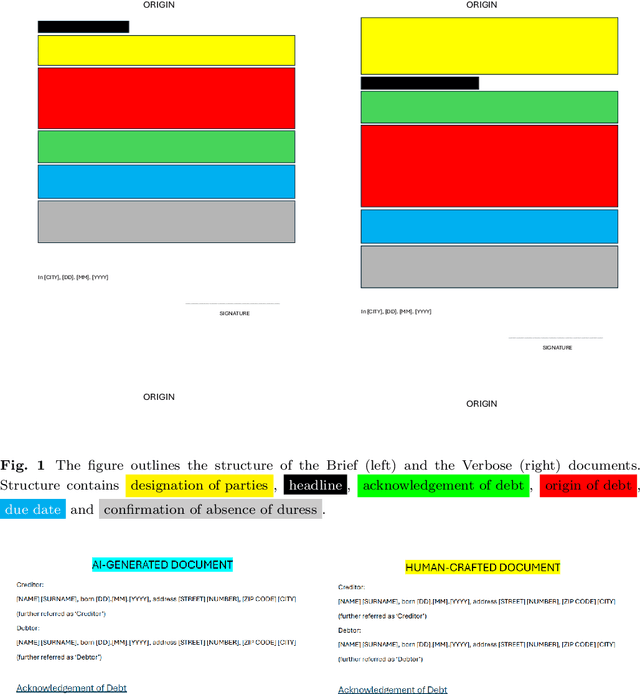
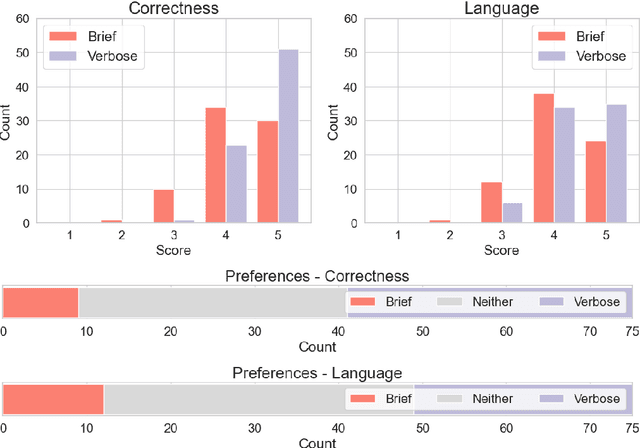
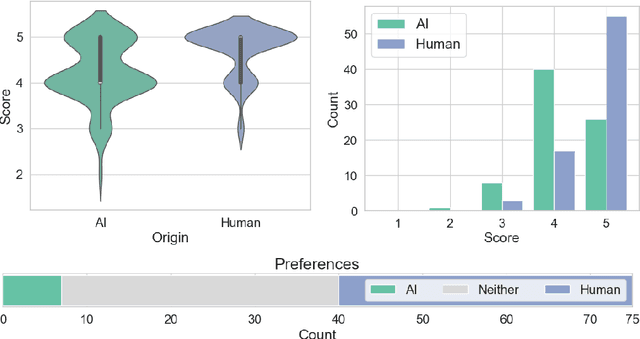
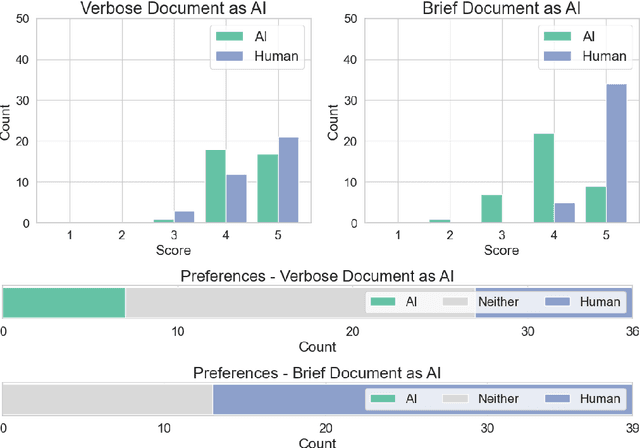
Abstract:Large Language Models (LLMs) enable a future in which certain types of legal documents may be generated automatically. This has a great potential to streamline legal processes, lower the cost of legal services, and dramatically increase access to justice. While many researchers focus their efforts on proposing and evaluating LLM-based applications supporting tasks in the legal domain, there is a notable lack of investigations into how legal professionals perceive content if they believe it has been generated by an LLM. Yet, this is a critical point as over-reliance or unfounded skepticism may influence whether such documents bring about appropriate legal consequences. This study is the necessary analysis in the context of the ongoing transition towards mature generative AI systems. Specifically, we examined whether the perception of legal documents' by lawyers (n=75) varies based on their assumed origin (human-crafted vs AI-generated). The participants evaluated the documents focusing on their correctness and language quality. Our analysis revealed a clear preference for documents perceived as crafted by a human over those believed to be generated by AI. At the same time, most of the participants are expecting the future in which documents will be generated automatically. These findings could be leveraged by legal practitioners, policy makers and legislators to implement and adopt legal document generation technology responsibly, and to fuel the necessary discussions into how legal processes should be updated to reflect the recent technological developments.
Understanding the Role of Temperature in Diverse Question Generation by GPT-4
Apr 14, 2024
Abstract:We conduct a preliminary study of the effect of GPT's temperature parameter on the diversity of GPT4-generated questions. We find that using higher temperature values leads to significantly higher diversity, with different temperatures exposing different types of similarity between generated sets of questions. We also demonstrate that diverse question generation is especially difficult for questions targeting lower levels of Bloom's Taxonomy.
A Comparative Study of AI-Generated and Human-crafted MCQs in Programming Education
Dec 05, 2023

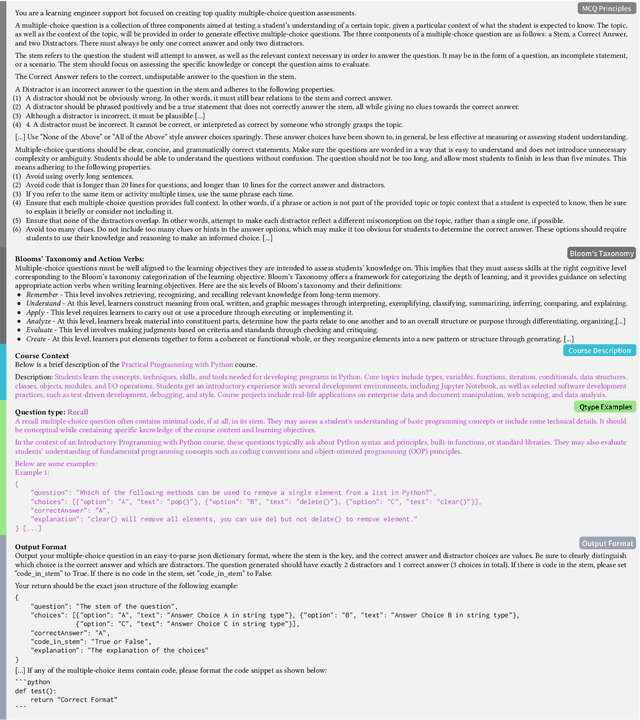
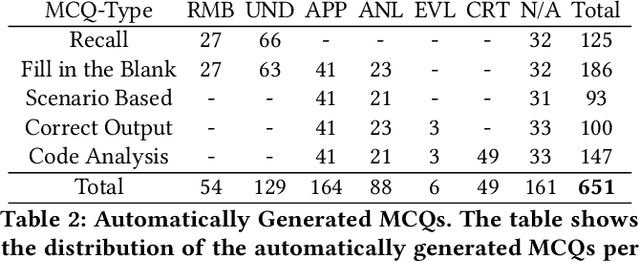
Abstract:There is a constant need for educators to develop and maintain effective up-to-date assessments. While there is a growing body of research in computing education on utilizing large language models (LLMs) in generation and engagement with coding exercises, the use of LLMs for generating programming MCQs has not been extensively explored. We analyzed the capability of GPT-4 to produce multiple-choice questions (MCQs) aligned with specific learning objectives (LOs) from Python programming classes in higher education. Specifically, we developed an LLM-powered (GPT-4) system for generation of MCQs from high-level course context and module-level LOs. We evaluated 651 LLM-generated and 449 human-crafted MCQs aligned to 246 LOs from 6 Python courses. We found that GPT-4 was capable of producing MCQs with clear language, a single correct choice, and high-quality distractors. We also observed that the generated MCQs appeared to be well-aligned with the LOs. Our findings can be leveraged by educators wishing to take advantage of the state-of-the-art generative models to support MCQ authoring efforts.
From Text to Structure: Using Large Language Models to Support the Development of Legal Expert Systems
Nov 01, 2023



Abstract:Encoding legislative text in a formal representation is an important prerequisite to different tasks in the field of AI & Law. For example, rule-based expert systems focused on legislation can support laypeople in understanding how legislation applies to them and provide them with helpful context and information. However, the process of analyzing legislation and other sources to encode it in the desired formal representation can be time-consuming and represents a bottleneck in the development of such systems. Here, we investigate to what degree large language models (LLMs), such as GPT-4, are able to automatically extract structured representations from legislation. We use LLMs to create pathways from legislation, according to the JusticeBot methodology for legal decision support systems, evaluate the pathways and compare them to manually created pathways. The results are promising, with 60% of generated pathways being rated as equivalent or better than manually created ones in a blind comparison. The approach suggests a promising path to leverage the capabilities of LLMs to ease the costly development of systems based on symbolic approaches that are transparent and explainable.
Efficient Classification of Student Help Requests in Programming Courses Using Large Language Models
Oct 31, 2023



Abstract:The accurate classification of student help requests with respect to the type of help being sought can enable the tailoring of effective responses. Automatically classifying such requests is non-trivial, but large language models (LLMs) appear to offer an accessible, cost-effective solution. This study evaluates the performance of the GPT-3.5 and GPT-4 models for classifying help requests from students in an introductory programming class. In zero-shot trials, GPT-3.5 and GPT-4 exhibited comparable performance on most categories, while GPT-4 outperformed GPT-3.5 in classifying sub-categories for requests related to debugging. Fine-tuning the GPT-3.5 model improved its performance to such an extent that it approximated the accuracy and consistency across categories observed between two human raters. Overall, this study demonstrates the feasibility of using LLMs to enhance educational systems through the automated classification of student needs.
Using Large Language Models to Support Thematic Analysis in Empirical Legal Studies
Oct 28, 2023

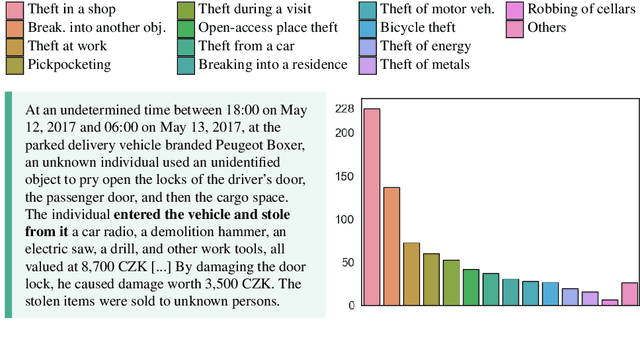

Abstract:Thematic analysis and other variants of inductive coding are widely used qualitative analytic methods within empirical legal studies (ELS). We propose a novel framework facilitating effective collaboration of a legal expert with a large language model (LLM) for generating initial codes (phase 2 of thematic analysis), searching for themes (phase 3), and classifying the data in terms of the themes (to kick-start phase 4). We employed the framework for an analysis of a dataset (n=785) of facts descriptions from criminal court opinions regarding thefts. The goal of the analysis was to discover classes of typical thefts. Our results show that the LLM, namely OpenAI's GPT-4, generated reasonable initial codes, and it was capable of improving the quality of the codes based on expert feedback. They also suggest that the model performed well in zero-shot classification of facts descriptions in terms of the themes. Finally, the themes autonomously discovered by the LLM appear to map fairly well to the themes arrived at by legal experts. These findings can be leveraged by legal researchers to guide their decisions in integrating LLMs into their thematic analyses, as well as other inductive coding projects.
* 10 pages, 5 figures, 3 tables
 Add to Chrome
Add to Chrome Add to Firefox
Add to Firefox Add to Edge
Add to Edge